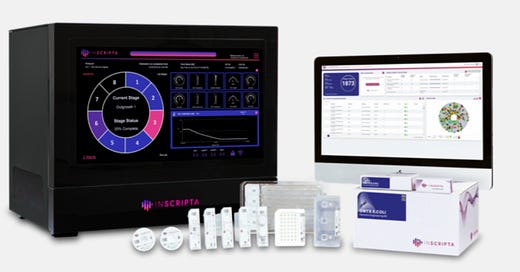Axial partners with great founders and inventors. We invest in early-stage life sciences companies such as Appia Bio, Seranova Bio, Delix Therapeutics, Simcha Therapeutics, among others often when they are no more than an idea. We are fanatical about helping the rare inventor who is compelled to build their own enduring business. If you or someone you know has a great idea or company in life sciences, Axial would be excited to get to know you and possibly invest in your vision and company . We are excited to be in business with you - email us at info@axialvc.com
Who leads Inscripta?
Inscripta was founded in 2015 originally named Muse Bio by Andrew Garst, Ryan Gill, and Tanya Lipscomb. Gill is a professor of chemical and biological engineering at University Colorado-Boulder, and Garst and Lipscomb were students there. In 2016, Kevin Ness (Co-Founder of 10X Genomics) was appointed CEO, replacing Ryan Gill to focus on commercialization of Inscripta’s products.
What does Inscripta do?
The focus of the company is to commoditize CRISPR gene editing and make genome engineering accessible to everyone. The core technology for Inscripta is a gene editing enzyme, MAD7 that they open sourced. MAD7 is an RNA-guided nuclease that the company open sourced: the enzyme is free to use for researchers with no licensing fees or royalties on products made using the technology. However, Inscripta does charge a royalty on non-R&D uses such as using MAD7 as a therapeutic or in a manufacturing process.
By making a gene editing enzyme more accessible when CRISPR effectors were in a patent battle between the Broad Institute and UC Berkeley, Inscripta used an open sourcing strategy to bootstrap an ecosystem and adoption around their gene editing method. The company has shown that MAD7 has successfully edited genes across a wide-range of cell types, comparable to Cas9, with different PAM recognition, high cut efficiencies, and lower off-target effects in some cases. Inscripta built software, instruments, and reagents to help their customers realize the value of commoditized gene editing.
The other part of Inscripta’s business is the instruments and consumables they sell. The company sells these gene editing products for customers in drug development, agriculture, and industrial biotechnology:
The company’s first instrument was ForgeCraft, a benchtop tool that enabled customers to edit microbes in a multiplex manner to create new libraries or genetic variants. The key value proposition for the product was trackable mutations.
In 2019, Inscripta released their Onyx device as a fully integrated platform of software design, customer reagents, and a benchtop instrument
What makes Inscripta unique?
Inscripta’s unique strategy of open sourcing MAD7 in a time when the IP of CRISPR gene editing was being battled over, provided the company with a beachhead to successfully commercialize their instruments.
The Onyx platform is initially focused on enabling genome engineering in E. coli and S. cerevisiae. With an automated workflow, the device can generate libraries of 10^4 edited cells in an experimental run. A major inflection point for the company will be when they bring the power of Onyx to mammalian cells.
Inscripta’s instrument, which they market as a benchtop biofoundry, allows:
A large number of parallel single and combinatorial edits for coding and non-coding regions from insertions to deletions - 10^2 to 10^4
Edit efficiencies above 30%
Library coverage above 70%
Software to assess a library’s quality
Source:
Why I like what Inscripta is doing?
Inscripta is making gene editing more accessible following the path of Illumina and 10X Genomics. The ability to generate a large number of genetic edits and measure the corresponding phenotypes is enabling for new products in life sciences. By developing new tools that allows more people to run these types of experiments potentially uncovering new areas of biology and empowering more to develop transformative medicines and products.
Once Onyx can be used for mammalian cells, Inscripta will have a large impact on everything from AAV gene therapies to biologics and cell therapies.
You can find Inscripta here.





